The island is the second largest in Greece, after Crete. Long and narrow, it stretches over the Aegean Sea very close alongside the shores of Mainland Greece, separated from it by the Gulf of Euboea and the famous Evripos Straits. A main highway and ferryboats from several terminals form the links with this island space, which is a center of attraction for those seeking natural beauty and scenic variety. There is something of interest to be seen at every turn in Euboea. Towns brisk with tourist traffic or peaceful villages, apparently forgotten by time.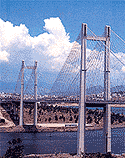 There are large fertile valleys and wooded mountainsides where mountain climbers can enjoy themselves as much as those opting, instead, for the attractions of the seashores with their excellent sandy beaches, organized bathing facilities and charming secluded coves.
There are large fertile valleys and wooded mountainsides where mountain climbers can enjoy themselves as much as those opting, instead, for the attractions of the seashores with their excellent sandy beaches, organized bathing facilities and charming secluded coves.
Modern life thrives alongside splendidly preserved tradition. There are picturesque country fairs where genuine, local customs survive. Euboea can promise and indeed offer its guests all this.
By road, Chalkida, the island’s capital, is accessible from a fork on the main Athens- Lamia highway. A swing bridge carries traffic across the narrow Evripos Straits with their tidal current, which Aristotle tried hard to explain in ancient times. The name Chalkida, taken by the town, which has been built over the site occupied by a very ancient city, is said to originate either from the copper which its inhabitants processed in olden times (Halkos means copper in Greek) or from the word “Halki”, which means a form of shell, used in antiquity for dying red fabrics. The ancient city was a renowned trading center, which established several colonies and contained famous temples dedicated to Zeus, Apollo and the goddess Hera.
The archaeological museum in the town contains notable exhibits such as the headless statue of the goddess Athena, the relief of Dionysus, the abduction of Antiope by Theseus and others. The Byzantine basilica of Aghia Paraskevi, located within the compound of the mediaeval fortress, contains coats of arms and inscriptions of the 14th century. The modern town has several hotels and its restaurants specialise in fish dishes.
Chalkida is the ideal starting point for an exploration of the whole island. Southward the road leads to Eretria, which, in ancient times, was the second most important city on the island, after Chalkida. It was a major maritime power and the standard of its intellectual activities was high. It was in Eretria that, in the 3rd century B.C., Menedimos, one of Plato’s pupils, founded the Eretrian School of Philosophy. Excavations, undertaken in 1891, reveal many monuments and statues. Interesting objects for the visitor to see are the ancient baths, the remains of the Temple of Dafniforos Apollo, the Palaestra with its fine mosaic and the ancient theater, unique in that it had a subterranean passage for use by the actors.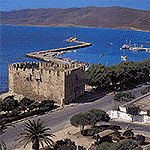 The ancestral homes of several renowned seafarers still stand in the town. In the museum there are finds dating back to prehistoric, archaic, classic and Hellenistic times. Eretria is also accessible by ferryboat from Oropos. The road from Chalkida to Eretria passes by the fine Malakonta beach which has ample facilities for tourists and then goes through the village of Vassiliko, which possesses distinctive local colour and a Venetian tower. Close by are the seaside settlements of Lefkanti and Kambos.
The ancestral homes of several renowned seafarers still stand in the town. In the museum there are finds dating back to prehistoric, archaic, classic and Hellenistic times. Eretria is also accessible by ferryboat from Oropos. The road from Chalkida to Eretria passes by the fine Malakonta beach which has ample facilities for tourists and then goes through the village of Vassiliko, which possesses distinctive local colour and a Venetian tower. Close by are the seaside settlements of Lefkanti and Kambos.
Continuing south along the coastal road, on the shores of the Gulf of Euboea, one comes upon the township of Amarinthas, which has a fine beach, tranquil surroundings and plenty of attractive fish dishes to offer. Nearby are the Byzantine churches of Metamorfossis and Kimissis Theotokou. At Vlihas there is a Macedonian grave. Ana Vathia is a quaint village with its Byzantine church of Zoodochos Pighi and the monastery of Aghios Nikolaos. Following along the foothills of Mt. Skliro, the road leads into the town of Aliveri with its spreading plain, its old tower and church of Aghios Loukas. In the same district stands the church of Aghios Nikolaos, which contains well-preserved Byzantine frescoes. At Aliveri there is a major electric power station.
Continuing south, the road comes upon the fork for Lepaurs from which it leads to Karistas. The area is thick with pinewoods and, in the past, fossils of pre-historic animals were found there. Inland lies the township of Stira where lots of streams flow amid spreading plane trees. There is also an ancient citadel. Nea Stira is on the coast, along a peaceful bay, which gives on to the Gulf of Euboea. It has well equipped bathing beach facilities. It is in this area that the “Dragon’s Houses” (“Spilia tou Drakou”) stand, consisting of huge, ancient blocks of stone. Further South is the village of Marmari.
All around are picturesque sites and excellent beaches. There is a ferryboat service to Rafina. Offshore is the islet of Petali. Still further south, the road follows the foothills of Mt. Ochi, whose summit has an altitude of 1398 M, and leads to Karistos, a town with a very ancient history, said to have been built by the Dryopes. The Venetians named it Castel Rosso because of the red stone with which they built their fortress there. It still stands.Another site worth visiting is Palaiochora where there are remains of ancient buildings and the noteworthy Byzantine church of Taxiarchon. There is also the Aghia Triada grotto with its spacious galleries.
If one goes back to the Lepoura fork and takes the road leading northeast, it will first skirt the well-wooded Mt. Dirfi (altitude 1,745 m.), which is the tallest mountain in Euboea. It then leads to the township of Kimi, which stands high up on the cliff, 250 m. above sea level, like a balcony overlooking the Aegean Sea.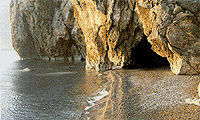 It is a town built with characteristic island picturesqueness. Many of its houses retain their pure traditional architecture. Directly opposite is the island of Skyros. Recently the Educational and Cultural Association of Kimi founded the town’s Folkloric Museum, which is housed in a typical neo-classic building. The exhibits cover the period from the year 1800 A.D. to the period between the two Great World Wars. Kimi has been known since ancient times and it is said that the town existed even before the Trojan War.
It is a town built with characteristic island picturesqueness. Many of its houses retain their pure traditional architecture. Directly opposite is the island of Skyros. Recently the Educational and Cultural Association of Kimi founded the town’s Folkloric Museum, which is housed in a typical neo-classic building. The exhibits cover the period from the year 1800 A.D. to the period between the two Great World Wars. Kimi has been known since ancient times and it is said that the town existed even before the Trojan War.
The surrounding district has numerous attractive villages, beaches, monasteries and plenty of woodland. At Honeftiko, set among poplar and fir trees, is a well-known medicinal spring. At Ano Patamia there are remains of an ancient city. The convent of Sotiros is tucked away on a steep slope. There is also a small, weather-beaten fortress, built by the Franks. The convent of Aghiou Haralambous Lefkon is also worth seeing. The Port of Kimi – called Paralia, 4 km from the town – is the departure point for ships calling at the Sporades islands.
If one sets out north from Chalkida, into the mountainous heart of the island of Euboea, the road leads to Steni Dirfias which is set in among plane trees with running streams, fir trees, pine trees and thick scrub which clings to the slopes of Mt. Dirfys. Both settlements of this village maintain their strict traditional character. It is the starting point for the climb to the alpine rest hut. Another very picturesque village in this area is Stropones. The outlet to the Aegean Sea from here is at Heiliadou, which has a fine beach and a church of the Kimissis Theotokou. The main motor highway, which traverses Northern Euboea, goes past Nea Artaki, dotted with tavernas, which serve fish food as their speciality. Nearby is the church of Faneromeni. Psahna, an attractive village a little further on, is the gateway to the hinterland of Northern Euboea. Politika is next with its Byzantine church of the Theotokou.
As the road begins to climb, the country becomes more wooded with plane trees, pine trees and firs. It is an astounding trip to the village of Prokopi with its church of Aghios loannis Rossos that attracts numerous pilgrims. The large village of Mantoudi, beyond Prokopi, overlooks the plain of ancient Kirintha from a height. There are plane trees and pine trees everywhere. The road then descends the mountainside of Kandili and passes through picturesque villages such as Skepasti and Kehries. The road leads into Limni a really charming township with a long history and well preserved traditions whose white houses are reflected in the waters of the Gulf of Euboea. According to legend, this was the site of ancient Elimnion where the wedding of Zeus to the goddess Hera was held. The ancient temple was destroyed by earthquake. Sites worth visiting are the excellent mosaics of the early Christian church, the chapel of Zoodochos Pighi and the well known convent of Galataki, built over the site of an ancient temple of Poseidon amid very impressive scenery and an almost incredible solitude. The convent is occupied by nuns.
There is also the attractive village of Rovies set in among olivegroves, which stretch right down to the sea. In this area, in ancient times, there was the “infallible oracle” of the Selinountios Apollo. In the same area stands the monastery of Osiou David Geronta, which contains fine 17th century frescoes.
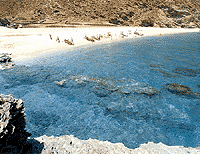 Driving on in the direction of the Aegean seaboard, the road leads into Aghia Ana, also known as Ayana which is really one of the most charming parts of all Euboea as it retains its strong traditional style, its customs and country fairs. The neighbouring Angali beach is also attractive with its extensive sands. The road then leads to Artemision, which is a Cape looking across the straits towards Mt. Pelion. Its ancient history is linked to the goddess Artemis who was supposed to go there hunting. There are remains of a temple dedicated to her. Other sites worth seeing are the churches of Aghia Paraskevi and Aghios Georgios. Slightly further North is the picturesque village or Pefki set in a pine forest. It has a fine beach. The road then traverses the peaceful and fertile plain of Istiea, which Homer described as “polystafyllon” (land of the many vines). According to legend, this is where the sacred bulls of the goddess Hera grazed. Orei, which is the port for Istiea, has characteristics entirely peculiar to itself with a Frankish fortress separating the town into two parts. To the West stand the ruins of another castle built upon the site of an earlier citadel. In the township there is the Byzantine church of Aghios Vasilios. Orei owe its importance to its dominating geographical position where, since olden times, it has been astride the channel which separates Euboea from the coast of Fthiotida opposite. Another, nearby pleasant seaside spot is Agiokambos with tavernas, which specialise in fish dishes. Its port is the starting point for the ferryboats to Glifa on the opposite coast.
Driving on in the direction of the Aegean seaboard, the road leads into Aghia Ana, also known as Ayana which is really one of the most charming parts of all Euboea as it retains its strong traditional style, its customs and country fairs. The neighbouring Angali beach is also attractive with its extensive sands. The road then leads to Artemision, which is a Cape looking across the straits towards Mt. Pelion. Its ancient history is linked to the goddess Artemis who was supposed to go there hunting. There are remains of a temple dedicated to her. Other sites worth seeing are the churches of Aghia Paraskevi and Aghios Georgios. Slightly further North is the picturesque village or Pefki set in a pine forest. It has a fine beach. The road then traverses the peaceful and fertile plain of Istiea, which Homer described as “polystafyllon” (land of the many vines). According to legend, this is where the sacred bulls of the goddess Hera grazed. Orei, which is the port for Istiea, has characteristics entirely peculiar to itself with a Frankish fortress separating the town into two parts. To the West stand the ruins of another castle built upon the site of an earlier citadel. In the township there is the Byzantine church of Aghios Vasilios. Orei owe its importance to its dominating geographical position where, since olden times, it has been astride the channel which separates Euboea from the coast of Fthiotida opposite. Another, nearby pleasant seaside spot is Agiokambos with tavernas, which specialise in fish dishes. Its port is the starting point for the ferryboats to Glifa on the opposite coast.
Turning back towards the Gulf of Euboea, the road leads to another important town on the island. This is the Edipsos spa, known since ancient times for its medicinal springs, mentioned by both Aristotle and Strabo and, nowadays one of the best-known Greek holiday resorts. It flourished in Roman times. On a hill close to Edipsos, lie the remains of the ancient city. There are remains of Roman baths at Aghii Anargyri and the Sylla Hot Springs (“Thermai”) near the sea. To the Northwest of Edipsos there is attractive countryside. Gialtra is a picturesque village in well-wooded surroundings with a good beach and natural medicinal springs. Its church of Theotokou has interesting frescoes. There is also Lihada, which is surrounded by forestland with its seaside settlement Aghios Georgios close by. At Profitis Elias there is a cave with stalactites. An excursion to Paleochori is pleasant as the village is very green amid plane trees and running streams. At the Northwest point of the island there is the convent of Aghios Georgios with a woodcarved altar screen and valuable relics.
Throughout Euboea, traditions are preserved, as well as picturesque local customs and all the year round there are various local country fairs in villages and at monasteries with folkdancing, folksongs and meals of local specialities.
 There are large fertile valleys and wooded mountainsides where mountain climbers can enjoy themselves as much as those opting, instead, for the attractions of the seashores with their excellent sandy beaches, organized bathing facilities and charming secluded coves.
There are large fertile valleys and wooded mountainsides where mountain climbers can enjoy themselves as much as those opting, instead, for the attractions of the seashores with their excellent sandy beaches, organized bathing facilities and charming secluded coves.Modern life thrives alongside splendidly preserved tradition. There are picturesque country fairs where genuine, local customs survive. Euboea can promise and indeed offer its guests all this.
By road, Chalkida, the island’s capital, is accessible from a fork on the main Athens- Lamia highway. A swing bridge carries traffic across the narrow Evripos Straits with their tidal current, which Aristotle tried hard to explain in ancient times. The name Chalkida, taken by the town, which has been built over the site occupied by a very ancient city, is said to originate either from the copper which its inhabitants processed in olden times (Halkos means copper in Greek) or from the word “Halki”, which means a form of shell, used in antiquity for dying red fabrics. The ancient city was a renowned trading center, which established several colonies and contained famous temples dedicated to Zeus, Apollo and the goddess Hera.
The archaeological museum in the town contains notable exhibits such as the headless statue of the goddess Athena, the relief of Dionysus, the abduction of Antiope by Theseus and others. The Byzantine basilica of Aghia Paraskevi, located within the compound of the mediaeval fortress, contains coats of arms and inscriptions of the 14th century. The modern town has several hotels and its restaurants specialise in fish dishes.
Chalkida is the ideal starting point for an exploration of the whole island. Southward the road leads to Eretria, which, in ancient times, was the second most important city on the island, after Chalkida. It was a major maritime power and the standard of its intellectual activities was high. It was in Eretria that, in the 3rd century B.C., Menedimos, one of Plato’s pupils, founded the Eretrian School of Philosophy. Excavations, undertaken in 1891, reveal many monuments and statues. Interesting objects for the visitor to see are the ancient baths, the remains of the Temple of Dafniforos Apollo, the Palaestra with its fine mosaic and the ancient theater, unique in that it had a subterranean passage for use by the actors.
 The ancestral homes of several renowned seafarers still stand in the town. In the museum there are finds dating back to prehistoric, archaic, classic and Hellenistic times. Eretria is also accessible by ferryboat from Oropos. The road from Chalkida to Eretria passes by the fine Malakonta beach which has ample facilities for tourists and then goes through the village of Vassiliko, which possesses distinctive local colour and a Venetian tower. Close by are the seaside settlements of Lefkanti and Kambos.
The ancestral homes of several renowned seafarers still stand in the town. In the museum there are finds dating back to prehistoric, archaic, classic and Hellenistic times. Eretria is also accessible by ferryboat from Oropos. The road from Chalkida to Eretria passes by the fine Malakonta beach which has ample facilities for tourists and then goes through the village of Vassiliko, which possesses distinctive local colour and a Venetian tower. Close by are the seaside settlements of Lefkanti and Kambos.Continuing south along the coastal road, on the shores of the Gulf of Euboea, one comes upon the township of Amarinthas, which has a fine beach, tranquil surroundings and plenty of attractive fish dishes to offer. Nearby are the Byzantine churches of Metamorfossis and Kimissis Theotokou. At Vlihas there is a Macedonian grave. Ana Vathia is a quaint village with its Byzantine church of Zoodochos Pighi and the monastery of Aghios Nikolaos. Following along the foothills of Mt. Skliro, the road leads into the town of Aliveri with its spreading plain, its old tower and church of Aghios Loukas. In the same district stands the church of Aghios Nikolaos, which contains well-preserved Byzantine frescoes. At Aliveri there is a major electric power station.
Continuing south, the road comes upon the fork for Lepaurs from which it leads to Karistas. The area is thick with pinewoods and, in the past, fossils of pre-historic animals were found there. Inland lies the township of Stira where lots of streams flow amid spreading plane trees. There is also an ancient citadel. Nea Stira is on the coast, along a peaceful bay, which gives on to the Gulf of Euboea. It has well equipped bathing beach facilities. It is in this area that the “Dragon’s Houses” (“Spilia tou Drakou”) stand, consisting of huge, ancient blocks of stone. Further South is the village of Marmari.
All around are picturesque sites and excellent beaches. There is a ferryboat service to Rafina. Offshore is the islet of Petali. Still further south, the road follows the foothills of Mt. Ochi, whose summit has an altitude of 1398 M, and leads to Karistos, a town with a very ancient history, said to have been built by the Dryopes. The Venetians named it Castel Rosso because of the red stone with which they built their fortress there. It still stands.Another site worth visiting is Palaiochora where there are remains of ancient buildings and the noteworthy Byzantine church of Taxiarchon. There is also the Aghia Triada grotto with its spacious galleries.
If one goes back to the Lepoura fork and takes the road leading northeast, it will first skirt the well-wooded Mt. Dirfi (altitude 1,745 m.), which is the tallest mountain in Euboea. It then leads to the township of Kimi, which stands high up on the cliff, 250 m. above sea level, like a balcony overlooking the Aegean Sea.
 It is a town built with characteristic island picturesqueness. Many of its houses retain their pure traditional architecture. Directly opposite is the island of Skyros. Recently the Educational and Cultural Association of Kimi founded the town’s Folkloric Museum, which is housed in a typical neo-classic building. The exhibits cover the period from the year 1800 A.D. to the period between the two Great World Wars. Kimi has been known since ancient times and it is said that the town existed even before the Trojan War.
It is a town built with characteristic island picturesqueness. Many of its houses retain their pure traditional architecture. Directly opposite is the island of Skyros. Recently the Educational and Cultural Association of Kimi founded the town’s Folkloric Museum, which is housed in a typical neo-classic building. The exhibits cover the period from the year 1800 A.D. to the period between the two Great World Wars. Kimi has been known since ancient times and it is said that the town existed even before the Trojan War.The surrounding district has numerous attractive villages, beaches, monasteries and plenty of woodland. At Honeftiko, set among poplar and fir trees, is a well-known medicinal spring. At Ano Patamia there are remains of an ancient city. The convent of Sotiros is tucked away on a steep slope. There is also a small, weather-beaten fortress, built by the Franks. The convent of Aghiou Haralambous Lefkon is also worth seeing. The Port of Kimi – called Paralia, 4 km from the town – is the departure point for ships calling at the Sporades islands.
If one sets out north from Chalkida, into the mountainous heart of the island of Euboea, the road leads to Steni Dirfias which is set in among plane trees with running streams, fir trees, pine trees and thick scrub which clings to the slopes of Mt. Dirfys. Both settlements of this village maintain their strict traditional character. It is the starting point for the climb to the alpine rest hut. Another very picturesque village in this area is Stropones. The outlet to the Aegean Sea from here is at Heiliadou, which has a fine beach and a church of the Kimissis Theotokou. The main motor highway, which traverses Northern Euboea, goes past Nea Artaki, dotted with tavernas, which serve fish food as their speciality. Nearby is the church of Faneromeni. Psahna, an attractive village a little further on, is the gateway to the hinterland of Northern Euboea. Politika is next with its Byzantine church of the Theotokou.
As the road begins to climb, the country becomes more wooded with plane trees, pine trees and firs. It is an astounding trip to the village of Prokopi with its church of Aghios loannis Rossos that attracts numerous pilgrims. The large village of Mantoudi, beyond Prokopi, overlooks the plain of ancient Kirintha from a height. There are plane trees and pine trees everywhere. The road then descends the mountainside of Kandili and passes through picturesque villages such as Skepasti and Kehries. The road leads into Limni a really charming township with a long history and well preserved traditions whose white houses are reflected in the waters of the Gulf of Euboea. According to legend, this was the site of ancient Elimnion where the wedding of Zeus to the goddess Hera was held. The ancient temple was destroyed by earthquake. Sites worth visiting are the excellent mosaics of the early Christian church, the chapel of Zoodochos Pighi and the well known convent of Galataki, built over the site of an ancient temple of Poseidon amid very impressive scenery and an almost incredible solitude. The convent is occupied by nuns.
There is also the attractive village of Rovies set in among olivegroves, which stretch right down to the sea. In this area, in ancient times, there was the “infallible oracle” of the Selinountios Apollo. In the same area stands the monastery of Osiou David Geronta, which contains fine 17th century frescoes.
 Driving on in the direction of the Aegean seaboard, the road leads into Aghia Ana, also known as Ayana which is really one of the most charming parts of all Euboea as it retains its strong traditional style, its customs and country fairs. The neighbouring Angali beach is also attractive with its extensive sands. The road then leads to Artemision, which is a Cape looking across the straits towards Mt. Pelion. Its ancient history is linked to the goddess Artemis who was supposed to go there hunting. There are remains of a temple dedicated to her. Other sites worth seeing are the churches of Aghia Paraskevi and Aghios Georgios. Slightly further North is the picturesque village or Pefki set in a pine forest. It has a fine beach. The road then traverses the peaceful and fertile plain of Istiea, which Homer described as “polystafyllon” (land of the many vines). According to legend, this is where the sacred bulls of the goddess Hera grazed. Orei, which is the port for Istiea, has characteristics entirely peculiar to itself with a Frankish fortress separating the town into two parts. To the West stand the ruins of another castle built upon the site of an earlier citadel. In the township there is the Byzantine church of Aghios Vasilios. Orei owe its importance to its dominating geographical position where, since olden times, it has been astride the channel which separates Euboea from the coast of Fthiotida opposite. Another, nearby pleasant seaside spot is Agiokambos with tavernas, which specialise in fish dishes. Its port is the starting point for the ferryboats to Glifa on the opposite coast.
Driving on in the direction of the Aegean seaboard, the road leads into Aghia Ana, also known as Ayana which is really one of the most charming parts of all Euboea as it retains its strong traditional style, its customs and country fairs. The neighbouring Angali beach is also attractive with its extensive sands. The road then leads to Artemision, which is a Cape looking across the straits towards Mt. Pelion. Its ancient history is linked to the goddess Artemis who was supposed to go there hunting. There are remains of a temple dedicated to her. Other sites worth seeing are the churches of Aghia Paraskevi and Aghios Georgios. Slightly further North is the picturesque village or Pefki set in a pine forest. It has a fine beach. The road then traverses the peaceful and fertile plain of Istiea, which Homer described as “polystafyllon” (land of the many vines). According to legend, this is where the sacred bulls of the goddess Hera grazed. Orei, which is the port for Istiea, has characteristics entirely peculiar to itself with a Frankish fortress separating the town into two parts. To the West stand the ruins of another castle built upon the site of an earlier citadel. In the township there is the Byzantine church of Aghios Vasilios. Orei owe its importance to its dominating geographical position where, since olden times, it has been astride the channel which separates Euboea from the coast of Fthiotida opposite. Another, nearby pleasant seaside spot is Agiokambos with tavernas, which specialise in fish dishes. Its port is the starting point for the ferryboats to Glifa on the opposite coast.Turning back towards the Gulf of Euboea, the road leads to another important town on the island. This is the Edipsos spa, known since ancient times for its medicinal springs, mentioned by both Aristotle and Strabo and, nowadays one of the best-known Greek holiday resorts. It flourished in Roman times. On a hill close to Edipsos, lie the remains of the ancient city. There are remains of Roman baths at Aghii Anargyri and the Sylla Hot Springs (“Thermai”) near the sea. To the Northwest of Edipsos there is attractive countryside. Gialtra is a picturesque village in well-wooded surroundings with a good beach and natural medicinal springs. Its church of Theotokou has interesting frescoes. There is also Lihada, which is surrounded by forestland with its seaside settlement Aghios Georgios close by. At Profitis Elias there is a cave with stalactites. An excursion to Paleochori is pleasant as the village is very green amid plane trees and running streams. At the Northwest point of the island there is the convent of Aghios Georgios with a woodcarved altar screen and valuable relics.
Throughout Euboea, traditions are preserved, as well as picturesque local customs and all the year round there are various local country fairs in villages and at monasteries with folkdancing, folksongs and meals of local specialities.
Chalkida
Chalkida is the capital of the prefecture of Evia and one of the ten largest by population cities in Greece. It is a modern town today, with many shops, banks, bars, restaurants and so on. This is also where the bridge and ferryboats to and from the mainland are. 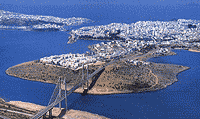 Here, you can visit an interesting archaeological museum and see the ruins of ancient temples, as well as a 15th century fortress.
Here, you can visit an interesting archaeological museum and see the ruins of ancient temples, as well as a 15th century fortress.
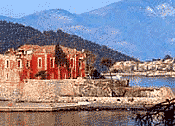 Chalkida is bult on two shores, Evia island and Viotia (prefecture on the mainland), giving the impression that Euripos strait is a wide river that runs through the city.
Chalkida is bult on two shores, Evia island and Viotia (prefecture on the mainland), giving the impression that Euripos strait is a wide river that runs through the city.
The capital Chalkida is linked to the mainland by an old-fashioned swing bridge and a modern suspended bridge, which is part of the motorway from Athens. The city also hosts the terminal rail station of the northern suburban train of Attica.
The Evripos Channel in Chalkida is surely Evia’s most noteworthy sight and boasts a 2500-year pedigree as a tourist attractio, thanks to the odd combination of land and currents, which make the tide change eight times a day. Since the building of the first bridge over the 30-meter wide narrows in the 5th century BC, people have wondered over the phenomenon. Aristotle is reputed to have thrown himself into the sea in exasperation at his inability to explain it.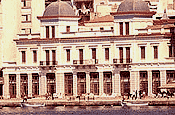 Signs of antiquity are not very evident in the modern city and archeology fans should head to the Archeological Museum, which houses finds from all over the island.
Signs of antiquity are not very evident in the modern city and archeology fans should head to the Archeological Museum, which houses finds from all over the island.
The waterfront of Chalkida is very popular among young people for both day and night entertainment. Nevertheless, in Evia you will not find much noisy nightlife, apart from some bar and clubs in and around Chalkida and some other resorts. Evia’s short distance from Athens attracts mainly week-enders seeking some relaxation along the beautiful beaches and fresh air in the leafy mountainside resorts, but above all some peace and quite away from the city bustle.
Chalkida is the favourite place of those enjoying seafood. The town is famed for its grilled octopus as well as for the varieties of shells and fishes, enjoyed better with a good quantity of ouzo. For a taste of the local artistry in cooking meat visit the mountain villages of Drifi to the north. Chalkida serves also as the main commercial centre of the region and it is the best place for shopping any kind of goods and in particular the locally produced honey, figs and splendid olive oil.
 Here, you can visit an interesting archaeological museum and see the ruins of ancient temples, as well as a 15th century fortress.
Here, you can visit an interesting archaeological museum and see the ruins of ancient temples, as well as a 15th century fortress.  Chalkida is bult on two shores, Evia island and Viotia (prefecture on the mainland), giving the impression that Euripos strait is a wide river that runs through the city.
Chalkida is bult on two shores, Evia island and Viotia (prefecture on the mainland), giving the impression that Euripos strait is a wide river that runs through the city.The capital Chalkida is linked to the mainland by an old-fashioned swing bridge and a modern suspended bridge, which is part of the motorway from Athens. The city also hosts the terminal rail station of the northern suburban train of Attica.
The Evripos Channel in Chalkida is surely Evia’s most noteworthy sight and boasts a 2500-year pedigree as a tourist attractio, thanks to the odd combination of land and currents, which make the tide change eight times a day. Since the building of the first bridge over the 30-meter wide narrows in the 5th century BC, people have wondered over the phenomenon. Aristotle is reputed to have thrown himself into the sea in exasperation at his inability to explain it.
 Signs of antiquity are not very evident in the modern city and archeology fans should head to the Archeological Museum, which houses finds from all over the island.
Signs of antiquity are not very evident in the modern city and archeology fans should head to the Archeological Museum, which houses finds from all over the island.The waterfront of Chalkida is very popular among young people for both day and night entertainment. Nevertheless, in Evia you will not find much noisy nightlife, apart from some bar and clubs in and around Chalkida and some other resorts. Evia’s short distance from Athens attracts mainly week-enders seeking some relaxation along the beautiful beaches and fresh air in the leafy mountainside resorts, but above all some peace and quite away from the city bustle.
Chalkida is the favourite place of those enjoying seafood. The town is famed for its grilled octopus as well as for the varieties of shells and fishes, enjoyed better with a good quantity of ouzo. For a taste of the local artistry in cooking meat visit the mountain villages of Drifi to the north. Chalkida serves also as the main commercial centre of the region and it is the best place for shopping any kind of goods and in particular the locally produced honey, figs and splendid olive oil.

